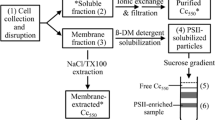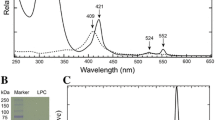Abstract
Cytochrome c 6 , (cyt c 6) a soluble monoheme electron transport protein, was isolated and characterized from the chlorophyll d-containing cyanobacterium Acaryochoris marina, the type strain MBIC11017. The protein was purified using ammonium sulfate precipitation, ion exchange and gel filtration column chromatography, and fast performance liquid chromatography. Its molecular mass and pI have been determined to be 8.87 kDa and less than 4.2, respectively, by mass spectrometry and isoelectrofocusing (IEF). The protein has an alpha helical structure as indicated by CD (circular dichroism) spectroscopy and a reduction midpoint potential (E m) of +327 mV versus the normal hydrogen electrode (NHE) as determined by redox potentiometry. Its potential role in electron transfer processes is discussed.







Similar content being viewed by others
Abbreviations
- cyt c 6 :
-
Cytochrome c 6
- FPLC:
-
Fast protein liquid chromatography
- IEF:
-
Isoelectrofocusing
- CD:
-
Circular dichroism
- E m :
-
Midpoint potential
- NHE:
-
Normal hydrogen electrode
- A. marina :
-
Acaryochloris marina
- PSI:
-
Photosystem I
- PC:
-
Plastocyanin
- IEC:
-
Ion exchange chromatography
- MALDI-TOF:
-
Matrix assisted laser desorption ionization-time of flight
- LC-MS/MS:
-
Liquid chromatography tandem mass spectrometry
- χ :
-
Fraction reduced
- A :
-
Absorbance
- A o :
-
Absorbance of fully oxidized species
- A r :
-
Absorbance of fully reduced species
- E :
-
potential
References
Bailleul B, Johnson X, Finazzi G, Barber J, Rappaport F, Telfer A (2008) The thermodynamics and kinetics of electron transfer between cytochrome b 6 f and photosystem I in the chlorophyll d-dominated cyanobacterium, Acaryochloris marina. J Biol Chem 283:25218–25226
Bialek W, Nelson M, Tamiola K, Kallas T, Szczepaniak A (2008) Deeply branching c 6 -like cytochromes of cyanobacteria. Biochemistry 47:5515–5522
Campos A, Aguiar A, Hervas M, Regalla M, Navarro J, Ortega J, Xavier A, De la Rosa M, Texiera M (1993) Cytochrome c 6 from Monoraphidium braunii: a cytochrome with an unusual heme axial coordination. Eur J Biochem 216:329–341
Chida H, Nakazawa A, Akazaki H, Hirano T, Suruga K, Ogawa M, Satoh T, Kadokura K, Yamada S, Hakamata W, Isobe K, Ito T, Ishii R, Nishio T, Sonoike K, Oku T (2007) Expression of the algal cytochrome c 6 gene in Arabidopsis enhances photosynthesis and growth. Plant Cell Physiol 48:948–957
Cho Y, Wang Q, Krogman D, Whitmarsh J (1999) Extinction coefficients and midpoint potentials of cytochrome c 6 from the cyanobacteria Arthrospira maxima, Microcystis aeruginosa, and Synechocystis 6803. Biochimica et Biophysica acta 1413:92–97
Cser K, Deak Z, Telfer A, Barber J, Vass I (2008) Energetics of photosystem II charge recombination in Acaryochloris marina studied by thermoluminescence and flash-induced chlorophyll fluorescence measurements. Photosynth Res 98:131–140
De la Cerda B, Diaz-Quintana A, Navarro J, Hervas M, De la Rosa M (1999) Site-directed mutagenesis of cytochrome c 6 from Synechocystis sp. PCC 6803. The heme protein possesses a negatively charged area that may be isofunctional with the acidic patch of plastocyanin. J Biol Chem 274:13292–13297
Diaz-Quintana A, Navarro J, Hervas M, Molina-Heredia F, De la Cerda B, De la Rosa M (2003) A comparative structural and functional analysis of cyanobacterial plastocyanin and cytochrome c 6 as alternative electron donors to photosystem I. Photosynth Res 75:97–110
Diaz-Quintana A, Hervas M, Navarro J, De la Rosa M (2008) Plastocyanin and cytochrome c 6 : the soluble electron carriers between the cytochrome b 6 f complex and photosystem I. In: Fromme P (ed) Photosytnethic protein complexes: a structural approach. Wiley-VCH Verlag GmBH & Co K. GaA, Weinheim, Germany
Dutton P (1978) Redox potentiometry: determination of midpoint potentials of oxidation-reduction components of biological electron-transfer systems. Methods Enzymol 54:411–435
Hou H, Mauzerall D (2006) The A-Fx to FA/B step in Synechostis 6803 photosystem I is entropy driven. JACS 128:1580–1586
Hu Q, Miyashita H, Iwasaki I, Kurano N, Miyachi S, Iwaki M, Itoh S (1998) A photosystem I reaction center driven by chlorophyll d in oxygenic photosynthesis. PNAS 95:13319–13323
Inda L, Erdner D, Peleato M, Anderson D (1999) Cytochrome c 6 isolated from the marine diatom Thalassiosira weissflogi. Phytochemistry 51:1–4
Kerfeld C, Krogman D (1998) Photosynthetic cytochromes c in cyanobacteria, algae, and plants. Annu Rev Plant Physiol 49:397–425
Marcaida M, Schlarb-Ridley B, Worrall J, Wastl J, Evans T, Bendall D, Luisi B, Howe C (2006) Structure of cytochrome c 6A , a novel dithio-cytochrome of Arabidopsis thaliana, and its reactivity with plastocyanin: implications for function. J Mol Biol 360:968–977
Medina M, Diaz A, Hervaz M, Navarro J, Gomez-Marino C, de la rosa M, Tollin G (1993) A comparative laser-flash absorption spectroscopy study of Anabaena PCC 7119 plastocyanin and cytochrome c 6 photooxidation by photosystem I particles. Eur J Biochem 213:1133–1138
Miller S, Augustine S, Olson T, Blankenship R, Selker J, Wood A (2005) Discovery of a free-living chlorophyll d- producing cyanobacterium with a hybrid proteobacterial/cyanobacterial subunit rRNA gene. PNAS 102:850–855
Miyashita H, Ikemoto H, Kurano N, Adachi K, Chihara M, Miyachi S (1996) Chlorophyll d as a major pigment. Nature 383:402
Nakamura A, Suzawa T, Kato Y, Watanbe T (2005) Significant species dependence of P700 redox potential as verified by spectroelectrochemistry: comparison of spinach and Thermosynnechoccus elongatus. FEBS Lett 579:2273–2276
Ohashi S, Miyashita H, Okada N, Iemura T, Watanabe T, Kobayashi M (2008) Unique photosystems in Acaryochloris marina. Photosynth Res 98:141–149
Proux-Delrourye V, Demaille C, Leibl W, Setif P, Bottin H, Bourdillon C (2003) Electrocatalytic investigation of light-induced electron transfer between cytochrome c 6 and photosystem I. JACS 125:13686–13692
Renger T, Schlodder E (2008) The primary electron donor of photosystem II of the cyanobacterium Acaryochloris marina is a chlorophyll d and the water oxidation is driven by a chlorophyll a/chlorophyll d heterodimer. J Phys Chem B 112:7351–7354
Schlenderin M, Cetin M, Schlodder E, Benson S, Sharma P, Barber J, Telfer A (2008) Reassessment of the redox potential of P740: the primary electron donor in photosystem I of the chlorophyll d containing cyanobacterium Acaryochloris marina. In: Allen J, Gantt E, Golbeck J, Osmond B (eds) Photosynthesis: energy from the Sun: 14th International Congress on Photosynthesis. Springer, New York
Steiner J, Serrano A, Allmaeir G, Jakowitsch J, Loffelhardt W (2000) Cytochrome c 6 from Cyanophora paradoxa Characterization of the protein and the cDNA of the precursor and import into isolated cyanelles. Eur J Biochem 267:4232–4241
Swingley W, Hohmann-Marriot M, Olsen T, Blankenship R (2005) Effects of iron on growth and ultrastructure of Acaryochloris marina. Appl Environ Microbiol 71:8606–8610
Swingley W, Chen M, Cheung C, Conrad A, Dejesa L, Hao J, Honchak B, Karbach L, Kurdoglu A, Lahiri S, Mastrian D, Miyashita H, Page L, Ramakrishna P, Satoh S, Sattley W, Shimada Y, Taylor H, Tomo T, Tsuchiya T, Wang Z, Raymond J, Mimuro M, Blankenship R (2008) Niche adaptation and genome expansion in the chlorophyll d-producing cyanobacterium Acaryochloris marina. PNAS 105:2005–2010
Tomo T, Kato Y, Suzuki T, Akimoto S, Okubo T, Noguchi T, Hasewaga K, Tohru T, Tanaka K, Michitaka Fukuya, Naoshi Dohmae, Watanbe T, Mimuro M (2008) Characterization of highly purified photosystem I complexes from the chlorophyll d-dominated cyanobacterium Acaryochloris MBIC 11017. JBC 283:18198–18209
Wen J, Zhang H, Gross M, Blankenship R (2009) Membrane orientation of the FMO antenna protein from Chlorobaculum tepidum as determined by mass spectrometry-based footprinting. Proc Natl Acad Sci USA. doi: 10.1073/pnas.0901691106
Worrall J, Schlarb-Ridley B, Reda T, Maracaida M, Moorlen R, Wastl J, Hirst J, Bendall D, Luisi B, Howe C (2007) Modulation of heme redox potential in the cytochrome c 6 family. JACS 129:9468–9475
Acknowledgments
We would like to thank the Washington University Mass Spectrometry Resource Center supported by NIH NCRR Grant No. 2P41RR000954 for their assistance. In addition, we would like to thank Jianzhong Wen for his help with the mass spectrometry and Aaron Collins for his help with the CD spectroscopy. This research was supported by a grant from the Exobiology program from NASA.
Author information
Authors and Affiliations
Corresponding author
Rights and permissions
About this article
Cite this article
Bell, P.D., **n, Y. & Blankenship, R.E. Purification and characterization of cytochrome c 6 from Acaryochloris marina . Photosynth Res 102, 43–51 (2009). https://doi.org/10.1007/s11120-009-9482-7
Received:
Accepted:
Published:
Issue Date:
DOI: https://doi.org/10.1007/s11120-009-9482-7




